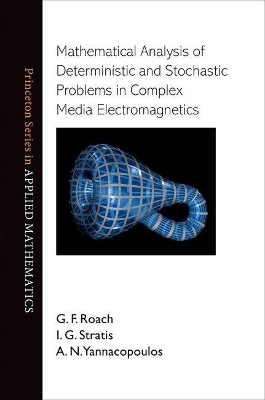
Mathematical Analysis of Deterministic and Stochastic Problems in Complex Media Electromagnetics
Princeton University Press (Verlag)
978-0-691-14217-3 (ISBN)
Electromagnetic complex media are artificial materials that affect the propagation of electromagnetic waves in surprising ways not usually seen in nature. Because of their wide range of important applications, these materials have been intensely studied over the past twenty-five years, mainly from the perspectives of physics and engineering. But a body of rigorous mathematical theory has also gradually developed, and this is the first book to present that theory. Designed for researchers and advanced graduate students in applied mathematics, electrical engineering, and physics, this book introduces the electromagnetics of complex media through a systematic, state-of-the-art account of their mathematical theory. The book combines the study of well posedness, homogenization, and controllability of Maxwell equations complemented with constitutive relations describing complex media. The book treats deterministic and stochastic problems both in the frequency and time domains. It also covers computational aspects and scattering problems, among other important topics.
Detailed appendices make the book self-contained in terms of mathematical prerequisites, and accessible to engineers and physicists as well as mathematicians.
G. F. Roach is professor emeritus in the Department of Mathematics and Statistics at the University of Strathclyde. I. G. Stratis is professor in the Department of Mathematics at the National and Kapodistrian University, Athens. A. N. Yannacopoulos is professor in the Department of Statistics at the Athens University of Economics and Business.
Preface xi PART 1. MODELLING AND MATHEMATICAL PRELIMINARIES 1 Chapter 1. Complex Media 3 Chapter 2. The Maxwell Equations and Constitutive Relations 9 2.1 Introduction 9 2.2 Fundamentals 9 2.3 Constitutive relations 13 2.4 The Maxwell equations in complex media: A variety of problems 23 Chapter 3. Spaces and Operators 38 3.1 Introduction 38 3.2 Function spaces 38 3.3 Standard difierential and trace operators 45 3.4 Function spaces for electromagnetics 48 3.5 Traces 51 3.6 Various decompositions 52 3.7 Compact embeddings 53 3.8 The operators of vector analysis revisited 54 3.9 The Maxwell operator 56 PART 2. TIME-HARMONIC DETERMINISTIC PROBLEMS 59 Chapter 4. Well Posedness 61 4.1 Introduction 61 4.2 Solvability of the interior problem 62 4.3 The eigenvalue problem 68 4.4 Low chirality behaviour 70 4.5 Comments on exterior domain problems 74 4.6 Towards numerics 77 Chapter 5. Scattering Problems: Beltrami Fields and Solvability 83 5.1 Introduction 83 5.2 Elliptic, circular and linear polarisation of waves 84 5.3 Beltrami fields - The Bohren decomposition 86 5.4 Scattering problems: Formulation 88 5.5 An introduction to BIEs 91 5.6 Properties of Beltrami fields 96 5.7 Solvability 99 5.8 Generalised Muller's BIEs 106 5.9 Low chirality approximations 108 5.10 Miscellanea 109 Chapter 6. Scattering Problems: A Variety of Topics 112 6.1 Introduction 112 6.2 Important concepts of scattering theory 113 6.3 Back to chiral media: Scattering relations and the far-field operator 118 6.4 Using dyadics 124 6.5 Herglotz wave functions 129 6.6 Domain derivative 136 6.7 Miscellanea 140 PART 3. TIME-DEPENDENT DETERMINISTIC PROBLEMS 149 Chapter 7. Well Posedness 151 7.1 Introduction 151 7.2 The Maxwell equations in the time domain 151 7.3 Functional framework and assumptions 152 7.4 Solvability 153 7.5 Other possible approaches to solvability 158 7.6 Miscellanea 162 Chapter 8. Controllability 163 8.1 Introduction 163 8.2 Formulation 163 8.3 Controllability of achiral media: The Hilbert Uniqueness method 165 8.4 The forward and backward problems 167 8.5 Controllability: Complex media 174 8.6 Miscellanea 176 Chapter 9. Homogenisation 180 9.1 Introduction 180 9.2 Formulation 181 9.3 A formal two-scale expansion 184 9.4 The optical response region 188 9.5 General bianisotropic media 199 9.6 Miscellanea 207 Chapter 10. Towards a Scattering Theory 212 10.1 Introduction 212 10.2 Formulation 213 10.3 Some basic strategies 214 10.4 On the construction of solutions 217 10.5 Wave operators and their construction 220 10.6 Complex media electromagnetics 225 10.7 Miscellanea 229 Chapter 11. Nonlinear Problems 231 11.1 Introduction 231 11.2 Formulation 231 11.3 Well posedness of the model 232 11.4 Miscellanea 241 PART 4. STOCHASTIC PROBLEMS 245 Chapter 12. Well Posedness 247 12.1 Introduction 247 12.2 Maxwell equations for random media 248 12.3 Functional setting 249 12.4 Well posedness 250 12.5 Other possible approaches to solvability 255 12.6 Miscellanea 261 Chapter 13. Controllability 263 13.1 Introduction 263 13.2 Formulation 263 13.3 Subtleties of stochastic controllability 264 13.4 Approximate controllability I: Random PDEs 266 13.5 Approximate controllability II: BSPDEs 269 13.6 Miscellanea 272 Chapter 14. Homogenisation 275 14.1 Introduction 275 14.2 Ergodic media 276 14.3 Formulation 279 14.4 A formal two-scale expansion 282 14.5 Homogenisation of the Maxwell system 284 14.6 Miscellanea 288 PART 5. APPENDICES 291 Appendix A. Some Facts from Functional Analysis 293 A.1 Duality 293 A.2 Strong, weak and weak-* convergence 295 A.3 Calculus in Banach spaces 297 A.4 Basic elements of spectral theory 300 A.5 Compactness criteria 303 A.6 Compact operators 304 A.7 The Banach-Steinhaus theorem 308 A.8 Semigroups and the Cauchy problem 308 A.9 Some fixed point theorems 312 A.10 The Lax-Milgram lemma 313 A.11 Gronwall's inequality 314 A.12 Nonlinear operators 315 Appendix B. Some Facts from Stochastic Analysis 316 B.1 Probability in Hilbert spaces 316 B.2 Stochastic processes and random fields 318 B.3 Gaussian measures 319 B.4 The Q- and the cylindrical Wiener process 320 B.5 The Ito integral 321 B.6 Ito formula 324 B.7 Stochastic convolution 325 B.8 SDEs in Hilbert spaces 325 B.9 Martingale representation theorem 326 Appendix C. Some Facts from Elliptic Homogenisation Theory 327 C.1 Spaces of periodic functions 327 C.2 Compensated compactness 329 C.3 Homogenisation of elliptic equations 329 C.4 Random elliptic homogenisation theory 332 Appendix D. Some Facts from Dyadic Analysis (by George Dassios) 334 Appendix E. Notation and abbreviations 341 Bibliography 343 Index 377
| Erscheint lt. Verlag | 4.3.2012 |
|---|---|
| Reihe/Serie | Princeton Series in Applied Mathematics |
| Verlagsort | New Jersey |
| Sprache | englisch |
| Maße | 152 x 235 mm |
| Gewicht | 680 g |
| Themenwelt | Mathematik / Informatik ► Mathematik ► Angewandte Mathematik |
| Naturwissenschaften ► Chemie ► Physikalische Chemie | |
| Naturwissenschaften ► Physik / Astronomie ► Elektrodynamik | |
| Technik ► Elektrotechnik / Energietechnik | |
| ISBN-10 | 0-691-14217-3 / 0691142173 |
| ISBN-13 | 978-0-691-14217-3 / 9780691142173 |
| Zustand | Neuware |
| Haben Sie eine Frage zum Produkt? |
aus dem Bereich


